 |
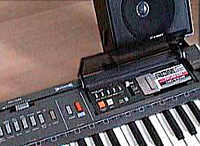 |
|
 |
 |
The original German retail price of the MT-800 in a German Conrad catalogue from 1986 was impressive 999DM (about 500€); a Casio MT-68 cost only the half. A rare fullsize variant of MT-800 was the Casio CT-810. Despite same hardware, the CT-810 (according to CasioNova site) did cost in 1984 enormous 899$.
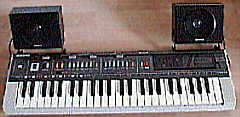
(old eBay photo) |
 |
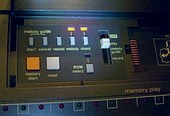 |
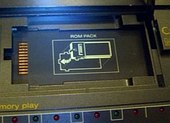 |
 |
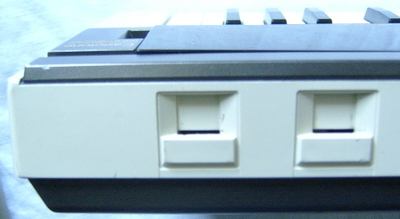 |
 |
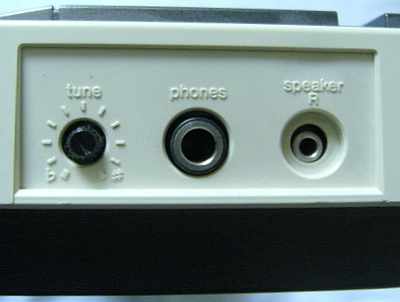 |
While the vibrato, reverb, envelope and octave select functions on other instruments were switched strictly by hand, the MT-800 uses only 12 well tweaked preset sounds those switch these features by themselves, which makes many presets sound much more natural than normal default presets on the Casio CT-410V (see there) despite they are still made from 2 mixed and filtered squarewaves. E.g. the "trumpet" sounds quite realistic now. The sounds "flute", "celesta", "violin", "synth. flute" are transposed 1 octave up. The "elec. guitar", "trumpet", "flute", "violin", "clarinet", "synth. flute" include a delayed vibrato. The "sustain" button in many sounds seems to activate rather the "reverb" effect of the D931C/ D930G chip set than the dedicated "sustain". (I don't know if the D930G behaviour change can be circumvented by modifications to regain full manual control over its many sound selection parameters like with the Casio MT-65/ MT-68 or my modified CT-410V.)
The stereo chorus is build on a fairly large analogue daughter board; it adds a mixture of panning, vibrato and a little chorus to the main voice sound to simulate a rotary speaker; but unlike with the CT-410V, here it can be only switched on or off; it has no speed control and runs slowly with only about 2Hz, which makes of the vibrato a strange mild howl. The intensity of the chorus component seems to be also lower than on the latter, thus the vibrato and panning is most audible.
Unlike the great CT-410V and all my other analogue Casio MT keyboards, the accompaniment of the MT-800 is very restricted since it recognizes only 12 standard establishment chords consisting of each 3 or 4 notes; with any other note combinations it plays only the lowest note as bass (which repeats within 1 octave and thus makes no good manual bass). Despite the very versatile D930G sound chip, this stubborn accompaniment uses always the same plain electronic organ tone for bass and chords, and unlike the predecessor MT-70 it has no arpeggio. Also in organ chord mode (without rhythm) the timbre can not even be switched by pressing different rhythm buttons. (Perhaps it was cut down to fit the ROM-Pack playback algorithm into the D930G ROM.) The only improvement in comparison to the CT-410V hardware is that this accompaniment does not reduce the main voice polyphony from 8 to 4 notes; possibly this was a limitation or bug of the keyboard polling algorithm in the D930G 11 firmware. The accompaniment always uses the stereo chorus, which gives especially the organ bass tone an interesting droning timbre (a bit like a propeller aeroplane). This analogue bass sounds soft and pressureful - a bit like a church organ.
The analogue percussion sounds much like with Casio CT-410V but the rhythms differ (likely by the external ROM and changed D930G software number). E.g. there are 2 different swing rhythms those don't exist in the CT-410V. The new rhythm set was likely standardized for ROM-Pack instruments, because they all include the same rhythm names although their percussion sounds different.
The sequencer is less awkward than on Casio MT-70, but it can not be edited anymore and thus is of little use (only melody and chord track can be erased separately). Also the "one key play" buttons of the latter are gone; only a "one key chord" button permits to play recorded chords one by one. Generally the MT-800 appears despite its external stereo speakers far less professional than the MT-70, because it has not only less main voice sounds and no display, but permits way less user controllable variations of given presets and behaves in some ways similarly stubborn than Casio's later ToneBank instruments. Quite interesting is that this instrument loads any played songs from the ROM-Pack cartridge first into the internal sequencer RAM (takes about 3 seconds; later keyboards like Casio PT-82 don't do this). Beside chord, rhythm and monophonic main voice, the ROM-Pack musics contain a 2nd monophonic melody voice (called "obligato" by Casio) which is apparently stored on an additional sequencer track. Unfortunately this track can not be recorded by hand (possibly a button can be added as an easteregg for this). ROM-Pack musics also contain instrumentation and rhythm changes, those can also not be recorded manually too. For play training, chord and melody track can be muted separately, but these buttons don't work while the sequence is playing. Great is that you can play (up to 4 note polyphonic!) while the sequencer is played back. The "obligato" voice volume can be only set together with the rest of the accompaniment; I badly miss a separate volume control for it because it tends to be too quiet.
The MT-800 seems to be indeed the very first ROM-Pack keyboard, because its behaviour has various glitches and is less elegant than later such instruments (e.g. Casio PT-80 and PT-82). These smaller instruments indicate e.g. with a walking light on the LED row above the keys that the user shall select a song number from the cartridge, and a click indicates that an empty number was selected, while a correct number starts that song. With the MT-800 instead there is only a static light above the key with the last selected song number, and during selection even the note of pressed keys still sound. (You can even play polyphonic on the keyboard in this mode, which was certainly not planned by Casio.) After selection you have to press "memory start" to load the song (possibly a safety measure because it overwrites the sequencer content). Selecting a non- existing song number or the rightmost key ("demo") selects the built-in demo song "Tanz der Stunden". On later instruments the rightmost key plays all songs on the cartridge in a sequence. Selecting instead of a melody number the keyboard key "F" (left next to the lowest number key) loads a lot of bizarre sounding (semi- random?) note mess into the sequencer. Other glitches include that after connection to supply voltage there is also mess in the sequencer and often the "sustain" or "stereo chorus" effects are active despite their locking buttons are not pushed in (press them to fix this). But like with later ROM-Pack instruments already here 2 lights indicate the keys for the current and next played note (current = lit, next = flashing), and you can select the melody guide either to wait for the player (press "start" to begin) or to continue with its programmed tempo (press "memory start" to begin). You can also switch the LED row off by pressing "cancel" before starting the melody guide; thus basically all 4 melody guide levels of the Casio PT-82 (but not the "rating" feature) already exist on this early instrument. While a song plays from the ROM-Pack, you can even switch the rhythm off and do many other manual things those with later ROM-Pack instruments don't work anymore.
My Casio MT-800 came with the default ROM-Pack RO-201
"Fun With Your Casio Keyboard", which contains 15 songs. Unlike my
other ROM-Packs it has a shiny sheet metal bottom instead of the usual
black plastic one. It is quite strange that this old instrument was shipped
with a 15 song cartridge, while later Casio keyboards came with ROM-Packs
with each only 4 songs, despite the price of ROM capacity certainly didn't
increase over the years. In the manual of this cartridge several other
ROM-Packs are advertised with also each >10 songs. With my MT-800
I also got the ROM-Pack RO-253
"Pop/ Rock".
hardware detailsThe Casio MT-800 employs almost the same D931C/ D930G chip set for sound generation like the CT-410V and even has a stereo chorus (but no VCA). Fortunately the MT-800 lacks the annoying muffling capacitor of the CT-410V, which made all sounds very dull. On the PCBs are various trimmer pots; 5 of them control percussion decay speed. Unlike CT-410V, here the semi-analogue percussion is partly integrated into 3 large hybrid modules.
Later I found out that the HN61364P is only an 8 KByte ROM (with PCB label "µPD2364EC"; all Casio chips with "D23..." seem to be ROMs). The corresponding part on the PCB of my Casio MT-85 is marked "µPD2364EC-074" (same part name in MT-800 service manual). Strange is that the HN61364P needs a pulldown resistors against GND at each data line to be read reliably in my eprommer. (I used 22 kOhm. On the MT-800 PCB is a strange resistor array.) Its correct pinout is 27C256 (not 27C64, else you get a bad dump where only every 4th byte is stable) with the 8KB data block starting at $4000; the rest is "00" and turns the data output off (high resistance; this type of ROM was also used in Casio MT-500 and MT-520.) The ROM seems to contain only rhythm/ accompaniment data and the demo song (confirmed by MT-800 service manual); when removed, the main voice still works, but rhythm is missing and instead of accompaniment there are only cacophonic steady tones (also in ROM-Pack music). Also the demo song doesn't work (behaves like song "F") but will play when it is still in RAM. The service manual tells that because the CPU data bus is 4-bit, the rom data output is divided into halves and sent twice. The current song from sequencer or ROM-Pack is kept in 2KB battery backed-up SRAM, consisting of 4 ICs "D444C" with each 4bit*1K (modern equivalent "NTE 2114"). According to MT-800 service manual, the 1st 1K bits of RAM 4 are used as system area and the rest of the 15K bits for memorizing a music. The MT-85 employs a single IC "HM6168HLP-70" instead. The software version of the accompaniment CPU D930G differs from standard MT-65; while the latter has "D930G 011", here it is "D930G 017" and in MT-85 even "D930G 018", and everything looks pretty overengineered. So all kinds of things get demuxed through 4 flipflop ICs TC40H174 those latch the level of address bus bits A0..A5 during rising edge of CPU pins O13..O16, and to save space, analogue percussion circuitry got integrated into 3 hybrid modules. The sound hardware resembles Casio MT-65 (see CT-410V)
but differs in chord handling because ROM-Pack playback repurposes 2 of
the channels (7th, arpeggio) for obligato voice. The main voice preset
sounds are routed through discrete fixed filters switched by pins IO1..IO3
of the sound IC. IO1 and IO3 enable LPF, IO2 disables the final HPF. IO4
mutes sound while switching. (The delayed vibrato is no external component
but listed with these in service manual.)
The obligato circuit is surprisingly complex. It combines several envelope and wave outs from the CPU and routes the result through 4 fixed filters to generate the 4 preset sounds {violin, organ, harpsichord, piano}. The currently selected preset sound state is latched from address lines to enable the corresponding parts. I did not expect this, because Robin Whittle's analysis of the main voice sound IC D931C suggest that it is multitimbrale (since it transmits sound definition data 8 times correspongding to the 8 polyphony channels). Perhaps Casio tried to avoid its restriction of using the same filter setting (because of only 1 DAC), or the lengthy D931C setup protocoll would have been too slow or cause glitches when ROM-Pack songs quickly switch obligato sounds. The obligato is routed through the 4-channel demultiplexer TC4052. The
muxed signals O37..O43 come from the CPU. O37 and O39 are waveforms. O43
is envelope. Control signals L41, L42 come from latch 2 (stored from address
bit A4 and A5 during rising edge of O16).
The percussion sounds are semi-analogue. This is what Casio considers
the official decay settings (fall time down to 50% of initial level).
keyboard matrixThis matrix was initially analyzed by me, later corrected from MT-800 service manual. The wiring is a complicated mess with muxed and inverted lines. So eastereggs may be incomplete since I barely understood what was going on. While the keys are in same places like MT-65, the rest of the layout is completely different.Matrix outputs KC1..KC10 from CPU are routed through a driver and then
an inverter. KC11, KC12, KC13 are multiplexed and get decoded by a flipflop
that stores the bits from CPU address lines A0, A1, A2 (those are the uninverted
KC1..KC3) during the rising edge of a pulse from O13. (The same principle
is used for many LEDs, obligato tone select, stereo chorus on/off etc.
those all store the state of an address line bit when a corresponding O#
line is rising.)
All unknown function names and in/ out numbers in this chart were chosen
by me. The input lines are active- low, i.e. react on GND, thus any functions
are triggered by a switch in series to a diode from one "in" to one "out"
pin.
ROM-Pack pinoutThis is the pinout of the ROM-Pack slot (pins counting from bottom to top).
In my Casio PT-82 (no ROM-Pack inserted) pins {1, 2 , 7..11}=hi, {3, 4}=lo, {5,6} = clock. The rom IC and connector inside a ROM-Pack has the same pinout. In Casio SK-5 service manual the names for +Vs and GND were confused (eh "negative logics") to confuse the mankind. Also the pin names vary (ø1 aka C1, ø2 aka C2, CP aka OP) and they used several different IC types. Despite the rom chip has much more pins, only the first 11 are used. Rom "OKI MS5268" (44 pin SMD, square) has additionally pin 17 and 39 internally connected with each other and to +Vs, but they are not used and the rest is anyway NC. Those with rom "Matsushita MN6404xxxx" (22 pin SMD, rectangular) have pins {12..22} externally shorted with each other. I haven't investigated this, but theoretically among unused additional pins may be bank switch eastereggs to enable hidden songs (to manufacture fewer different IC types) or in worse case PROM write pins those may overwrite the contents if fed with wrong signals (in 1980th ICs usually above supply voltage). The ROM-Pack pinout is closely related to the 4-bit bus of programmable Casio calculators and the special SRAM HD61914, which was also used in the RAM-Pack RA-1 made for the ROM-Pack slot of Casio PT-50. Despite the RA-1 fits into other ROM-Pack keyboards as well, they silently ignore it. The concept of this bus was quite versatile and can be almost considered a predecessor of USB; in calculators beside SRAM and ROM it e.g. also supported datasette and printers. So it might be possible to design a midi interface for the ROM-Pack slot that can take control over other instrument functions too. Meanwhile other people have deciphered the ROM-Pack protocoll. The MT-800 service manual contains interesting info. So a ROM-Pack is claimed to have 192K-bit capacity and contains 20 soungs data. quote: "ROM-Pack contains 196,608 K-bit ROM. To read data from the ROM pack, CPU sends address signal A4 ~ A7 and reads the addressed data from DB1 ~ DB4 terminals. However, ROM pack does not have address bus terminals, memory is addressed by terminals D1 ~ D4 when signal OP is at "L" level."The text includes a possibly Freudian slip: "When a music of a ROM pack is played, music data is transfered from ROM pack to CPU and from CPU to RAM pack. Then music data is taken from RAM to CPU in turn..."May this mean that the MT-800 was planned to support an actual (removable) RAM-Pack like in PT-50?? (My RA-1 does nothing when inserted into MT-800.) |
Predecessor of the MT-800 was the Casio MT-70 (with barcode pen instead of ROM cartridges). Successors were likely the MT-820 and MT-88 (both similar, with internal speakers). In eBay announces some people claimed that you could also save own musics from the sequencer onto the ROM-Pack "diskette", but I guess this was just a wrong description; I have tested to insert the RAM-Pack RA-1 of my PT-50 into the MT-85 (hardware like MT-800), but it gets simply ignored. The likely last non- toy Casio keyboard with ROM-Pack slot was the Casio CT-840.
In my German MT-85 manual there is even a typo somewhere that calls the keyboard "MT-800". The manual claims that it was packaged with the ROM-Pack RO-201 (like with MT-800) while my used specimen came with a RO-551. A brown MT-85 version was released as Casio MT-86 (seen on eBay).
 |
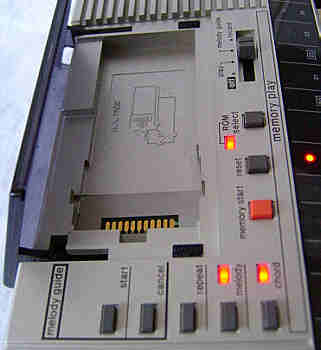 |
 |
 |
 |
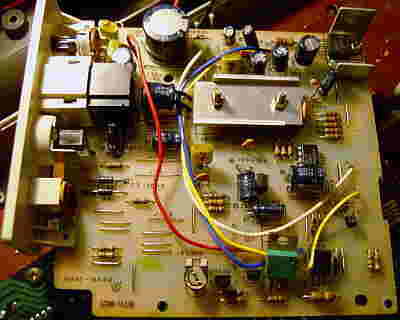 |
 |
 |
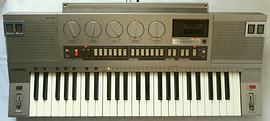 |
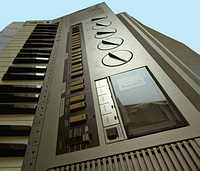 |
I bought mine from an eBay scammer in very bad condition with missing screws and full of scratches.
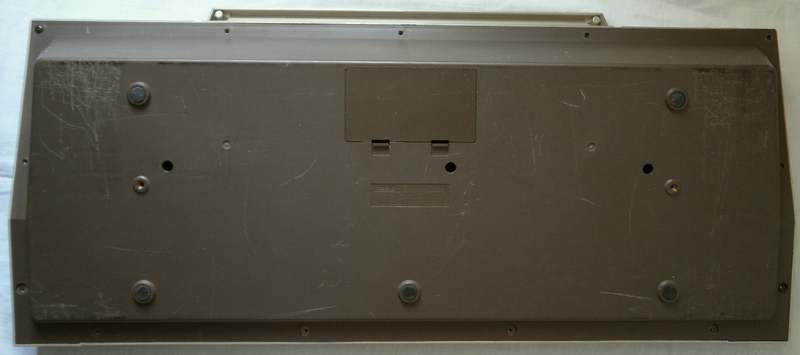 |
 |
 |
 |
hardware detailsThe Casio CT-810 is technically identical with MT-800 (see there) but has a less crowded case, so the hardware is more pleasant to work on.
|
Competitor of the first polyphonic ROM-Pack keyboards was the PlayCard
system of Yamaha PC-100 that came
out 1 year earlier.
| removal of these screws voids warranty... | ||
 |
||
|
|